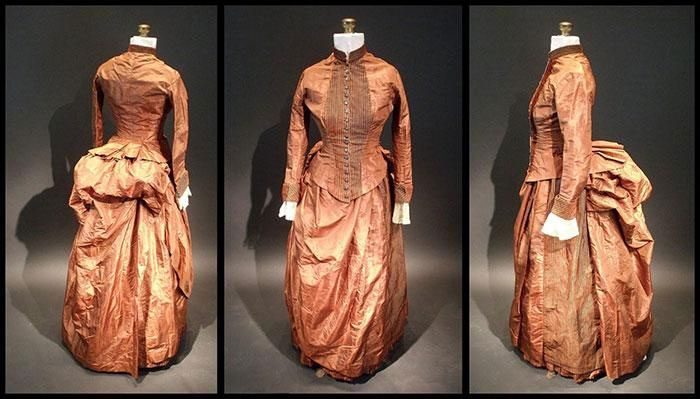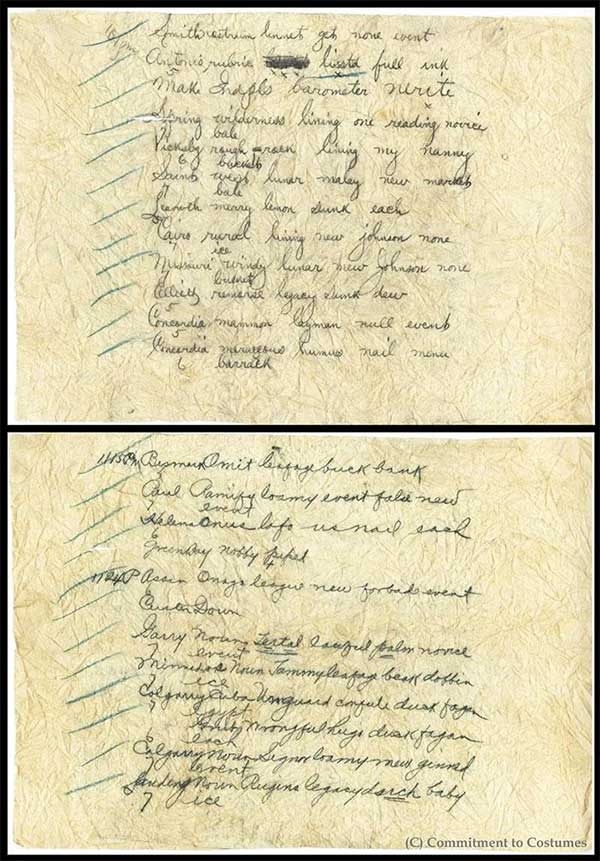An antique dress purchased a decade ago contains mysterious messages encoded from the 19th century, revealing that it is a weather observation tool of the United States Army Signal Corps.
This discovery enhances our understanding of historical meteorological observation activities.
In 2013, Sara Rivers Cofield spotted a brown dress for sale at an antique mall in Maine.
As an archaeologist and a collector of vintage dresses and bags, Sara was immediately drawn to the metallic buttons and the intricate lace of the dress.
Upon bringing the dress home, she discovered a secret pocket hidden beneath the lining, containing crumpled pieces of paper.

The antique dress with mysterious messages. (Photo: Sara Rivers Cofield/Commitment to Costumes).
Sara believed both the dress and the paper could date back to the 1880s, but she could not fully comprehend the meaning of the messages written on them.
According to the National Oceanic and Atmospheric Administration (NOAA), some of the inscriptions begin with location names, followed by seemingly random verbs and nouns.
Sara described her findings on her personal blog: “Additionally, there are numbers interspersed between the lines, each line marked by a different color, and there are strange notes, similar to timestamps like 10 PM, 11 PM 13 minutes, and 11 PM 24 minutes. I felt like these clues were really pointing to some kind of code.”

Mysterious coded lines on the antique dress. (Photo: Sara Rivers Cofield/Commitment to Costumes).
After Sara posted a call for decoding online, various forums around the world, such as Reddit, offered numerous theories, ranging from love notes to clothing measurements, and even illegal gambling or wartime codes.
However, antique dealers and more experienced cryptographers dismissed these hypotheses. Some suggested it might be a type of telegraphic code related to the burgeoning communication infrastructure that began to spread worldwide in the 1800s.
According to NOAA, the invention of the telegraph revolutionized news sharing in the mid-1800s, allowing people to quickly send messages from one town to another.

(Photo: Sara Rivers Cofield/Commitment to Costumes).
Researcher Wayne Chan from the University of Manitoba (Canada) explained in an article: “Since telegraph companies charged by the number of words in a telegram, many conventional coded words were devised to reduce the word count.”
However, Wayne Chan and many other experts could not identify the type of code on the dress. This case has been listed among the 50 most mysterious codes in the world over the past decade.
With a determination to solve the mystery, Wayne Chan read 170 books about telegraphy. He then decided to delve deeper into the telegraph era.
Ultimately, Wayne discovered in an old book content about weather codes used by the U.S. Army Signal Corps. There, the researcher found examples similar to the code writing on the dress, leading him to believe that the code pertained to weather.

Location of the pocket containing the mysterious codes within the dress lining. (Photo: Sara Rivers Cofield/Commitment to Costumes).
Experts believe that the advent of the telegraph revolutionized weather forecasting, allowing weather news to be transmitted over long distances. However, to save costs, meteorological variables needed to be abbreviated into code.
As a result, the code on the silk dress may have been used by the U.S. Army Signal Corps from 1870 to 1891. This division is also the precursor to the National Weather Service under NOAA.
Based on some available documents, Wayne Chan concluded that the messages originated from weather stations of the Army Signal Corps in the U.S. and Canada. Each line provided information about the weather observed at a specific location and time of day. This information was telegraphed to the headquarters of the Army Signal Corps in Washington, D.C.
In summary, according to Wayne Chan, this is a weather code used by the U.S. Army Signal Corps during the period of 1870-1891. Further research identified that these weather observations were made on May 27, 1888.
There are still some unresolved mysteries. For instance, NOAA does not know who owned the dress or why this person stuffed weather codes into the aforementioned pocket.
Sara believes this is not a dress meant for attending a ball. It resembles work attire from that era more. Meanwhile, Wayne Chan noted that some women worked in the offices of the Army Signal Corps in Washington during the 1880s.

A small label reading “Bennett” inside the dress. (Photo: Sara Rivers Cofield/Commitment to Costumes).
A small label found inside the dress reads “Bennett.” However, researchers have not found information about any woman named Bennett who worked there.
In the meantime, a man named Maitland Bennett is believed to have worked as a clerk there during this period, and his wife may have owned the dress.
However, this woman was reportedly eight months pregnant at the time of the coded weather observations, making it unlikely she could have worn it.
Sara lamented: “Everyone loves a mystery!”


















































